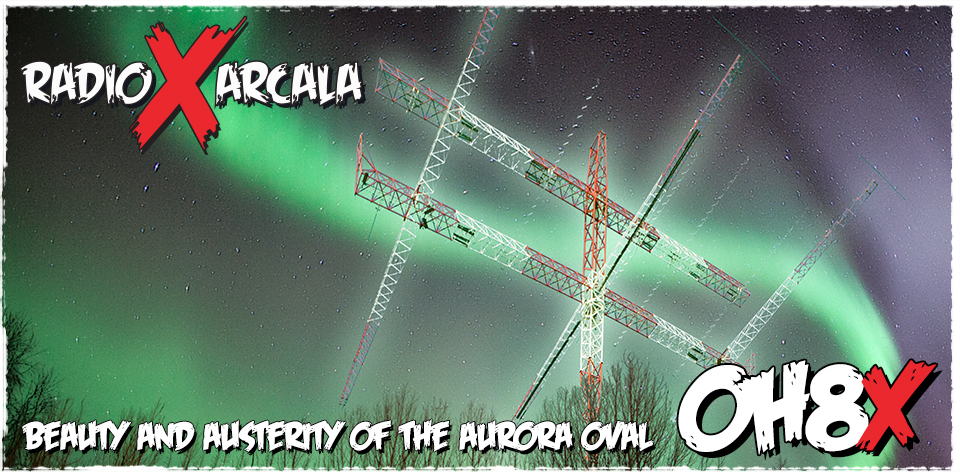LIFE UNDER THE AURORAL OVAL UP IN THE NORTHERN PARTS
Upon reaching the Arctic Circle visitors will witness the eighth wonder of the world and are likely to find life seemingly tough, with everything turned against those living there. During a winter’s day, the sun is gone, while in summer Old Sol does not set at all. Temperatures fall to record lows, with heavy ice and snow covering everything. Often the Northern Lights, Nature’s fireworks, kill radio propagation for weeks on end and the Auroral Oval sits over the barren tundra on more days than not. Life seems to grind to a halt and people just have to figure out how to make the best of it.
And here comes the trick. Survival teaches them to appreciate the little things they have, and then collectively they make the things they need and more. They know how to make a fire and how to catch fish from their innumerable rivers. In their own way, they are perfectly equipped comfortably to survive the freezing winter and they get things done because there is no easy life, and Visa cards will not buy them comfort as such. Their life is in their own dexterous hands.
Come summer and the region’s deep seasonality is revealed once again. The locals start using their skills to do things the way that others only dream about. Rapids shooters fight against the violent currents of crystal clear rivers, and they take visitors on tours of a lifetime. Whatever they do has a human touch. They are the folks from the Deep North. They are the Extremes.
These people have turned their seemingly barren land into an attractive landscape that thousands come to experience during all seasons from near and far. The region is noted for its very popular nature tourism, and the Santa Claus Airport in the regional capital Rovaniemi is the busiest airport in the whole of the Arctic; together with the related Santa Claus Village it is a dream for visiting youngsters from all over the world. They have proudly established a leading technical university in Oulu and built the entire city as a marvel of technology with Nature in mind and concern for the environment as a guiding principle.
With their Lapland mindset, the Northern types create never-seen-before technology and break all barriers to practical and enjoyable life. They drive the best technology and they can go bigger and better than those blessed with an eternal summer on other latitudes because the Arcala whiz kids come from the inspiring North.
These 250 words are to introduce Arcala Extremes, OH8X – the northernmost amateur radio alliance, pushing the envelope higher than others. Their antennas reach higher, their structures are more massive and they employ the latest telecommunications art to do new things with a smile and youthful energy.
Their results are something that others can only marvel at. And when Mother Nature brings the summer, they hone their skills to harvest the crops and come up with the fruits of their labor. They are the men of iron, sculptured from ice and snow and galvanized by the spirit of Aurora Borealis. They speak their own strange language, or fall silent at times, but they get things done – and more.
- Arctic Circle
- Aurora Borealis
- City of Oulu
- City of Rovaniemi
- Global warming and other temperature trends
- Lapland
- Sámi Museum and the Northern Lapland Nature Centre
- Santa Claus
- Weather in Arcala
- Web-cam Pallas-Ylläs National Park
- Virtual Finland
- Visit Finland
Aurola Borealis – The Northen Lights
Written for Virtual Finland by Joe BradyPhotos © Martti Rikkonen
From: http://virtual.finland.fi
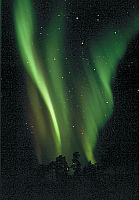 My earliest recollection of the Aurora Borealis, the Northern Lights, is from a song of the 1950s called “the Northern Lights of Old Aberdeen”, which I always took to be a reference not to Scottish traffic arrangements but to the celestial phenomenon of bands, curtains or streamers of coloured light that appear in the sky predominantly in the Arctic and Antarctic regions of the earth. In the Antarctic, the lights are called the Aurora Australis, or Southern Lights. They are visible, though less frequently, also outside those zones. I do not know how often the Northern Lights appear in northern Scotland but in the far north of this country, in Finnish Lapland, the number of auroral displays can be as high as 200 a year. In southern Finland the number is usually fewer than 20.
My earliest recollection of the Aurora Borealis, the Northern Lights, is from a song of the 1950s called “the Northern Lights of Old Aberdeen”, which I always took to be a reference not to Scottish traffic arrangements but to the celestial phenomenon of bands, curtains or streamers of coloured light that appear in the sky predominantly in the Arctic and Antarctic regions of the earth. In the Antarctic, the lights are called the Aurora Australis, or Southern Lights. They are visible, though less frequently, also outside those zones. I do not know how often the Northern Lights appear in northern Scotland but in the far north of this country, in Finnish Lapland, the number of auroral displays can be as high as 200 a year. In southern Finland the number is usually fewer than 20.
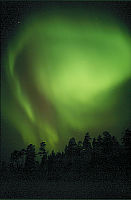 Folklore abounds with explanations of the origins of the spellbinding celestial lights. In Finnish they are called “revontulet”, which means “fox fires” a name derived from an ancient fable of the arctic fox starting fires fire or spraying up snow with its brush-like tail. No matter that in English “foxfire” is a luminescent glow emitted by certain types of fungi growing on rotten wood. The true story is that the sun is the father of the auroras.
Folklore abounds with explanations of the origins of the spellbinding celestial lights. In Finnish they are called “revontulet”, which means “fox fires” a name derived from an ancient fable of the arctic fox starting fires fire or spraying up snow with its brush-like tail. No matter that in English “foxfire” is a luminescent glow emitted by certain types of fungi growing on rotten wood. The true story is that the sun is the father of the auroras.
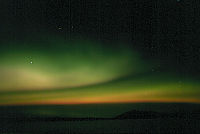 The sun gives off high-energy charged particles (also called ions) that travel out into space at speeds of 300 to 1200 kilometres per second. A cloud of such particles is called a plasma. The stream of plasma coming from the sun is known as the solar wind. As the solar wind interacts with the edge of the earth’s magnetic field, some of the particles are trapped by it and they follow the lines of magnetic force down into the ionosphere, the section of the earth’s atmosphere that extends from about 60 to 600 kilometres above the earth’s surface. When the particles collide with the gases in the ionosphere they start to glow, producing the spectacle that we know as the auroras, northern and southern. The array of colours consists of red, green, blue and violet.
The sun gives off high-energy charged particles (also called ions) that travel out into space at speeds of 300 to 1200 kilometres per second. A cloud of such particles is called a plasma. The stream of plasma coming from the sun is known as the solar wind. As the solar wind interacts with the edge of the earth’s magnetic field, some of the particles are trapped by it and they follow the lines of magnetic force down into the ionosphere, the section of the earth’s atmosphere that extends from about 60 to 600 kilometres above the earth’s surface. When the particles collide with the gases in the ionosphere they start to glow, producing the spectacle that we know as the auroras, northern and southern. The array of colours consists of red, green, blue and violet.
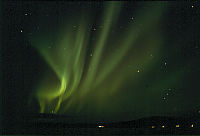 The Northern Lights are constantly in motion because of the changing interaction between the solar wind and the earth’s magnetic field. The solar wind commonly generates up to 1000,000 megawatts of electricity in an auroral display and this can cause interference with power lines, radio and television broadcasts and satellite communications. By studying the auroras, scientists can learn more about the solar wind, how it affects the earth’s atmosphere and how the energy of the auroras might be exploited for useful purposes.
The Northern Lights are constantly in motion because of the changing interaction between the solar wind and the earth’s magnetic field. The solar wind commonly generates up to 1000,000 megawatts of electricity in an auroral display and this can cause interference with power lines, radio and television broadcasts and satellite communications. By studying the auroras, scientists can learn more about the solar wind, how it affects the earth’s atmosphere and how the energy of the auroras might be exploited for useful purposes.
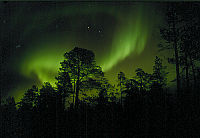 An important centre for this type of geophysical study is located in Sodankylä, a small community in the heart of Finnish Lapland, at latitude 67.4 degrees north. It is an excellent location for probing the secrets of the earth’s geomagnetic field. It was here that the Finnish Academy of Science and Letters established a geophysical observatory in 1913. Today, the Sodankylä Geophysical Observatory (SGO) is run by the University of Oulu. In addition to research the observatory performs routine geophysical measurements at its different stations. They produce ionospheric, geomagnetic and auroral data as well as seismic, cosmic ray data from Finland.
An important centre for this type of geophysical study is located in Sodankylä, a small community in the heart of Finnish Lapland, at latitude 67.4 degrees north. It is an excellent location for probing the secrets of the earth’s geomagnetic field. It was here that the Finnish Academy of Science and Letters established a geophysical observatory in 1913. Today, the Sodankylä Geophysical Observatory (SGO) is run by the University of Oulu. In addition to research the observatory performs routine geophysical measurements at its different stations. They produce ionospheric, geomagnetic and auroral data as well as seismic, cosmic ray data from Finland.
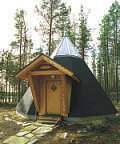 The observatory and its associated research units nearby form a scientific community devoted to work that has global significance. There are high hopes that the brainwork of the scientists will also have beneficial effects on the local economy in this part of Lapland. The idea is that the findings of scientific research can be used to attract high-tech firms to the area, generating jobs and stimulating commercial activity. Already tourists can visit the privately operated “revontulikota”, an auroral observatory and planetarium built in the shape of the traditional Lapp dwelling that is known as a “kota”.
The observatory and its associated research units nearby form a scientific community devoted to work that has global significance. There are high hopes that the brainwork of the scientists will also have beneficial effects on the local economy in this part of Lapland. The idea is that the findings of scientific research can be used to attract high-tech firms to the area, generating jobs and stimulating commercial activity. Already tourists can visit the privately operated “revontulikota”, an auroral observatory and planetarium built in the shape of the traditional Lapp dwelling that is known as a “kota”.
The finest display in living memory
 The finest display of the Northern Lights seen in southern Finland within living memory appeared in the sky on the nights of April 6th and 7th, 2000. In Helsinki, about as far south as you can go in Finland, hundreds of excited people roused their friends from sleep in the small hours with the words, “Don’t ask, just go outside now, you won’t believe your eyes.”
The finest display of the Northern Lights seen in southern Finland within living memory appeared in the sky on the nights of April 6th and 7th, 2000. In Helsinki, about as far south as you can go in Finland, hundreds of excited people roused their friends from sleep in the small hours with the words, “Don’t ask, just go outside now, you won’t believe your eyes.”
The Finnish magazine for serious skywatchers, “Tähdet ja Avaruus”, (Stars and Space) devoted a special 17-page supplement to the extraordinary spectacle, headlining it as “The Northern Hemisphere Aflame”. Well, at least Finland’s part of it was. A leading photographer of celestial phenomena, Pekka Parviainen, used up 19 rolls of film, saying afterwards that nothing he had ever seen in 29 years of waiting and watching came close to the visions of that cold night in early spring.
Here you’ll find six of Parviainen’s best shots, taken between 02.20 and 03.00 at Mynämäki in south-west Finland.
